Smithsonian Arts and Industries Building
Introduction
Text-to-speech Audio
Images
The Arts and Industries Building complements the red brick of the Smithsonian Castle and presents a unique design on the National Mall. Photo courtesy of the Smithsonian Institution.
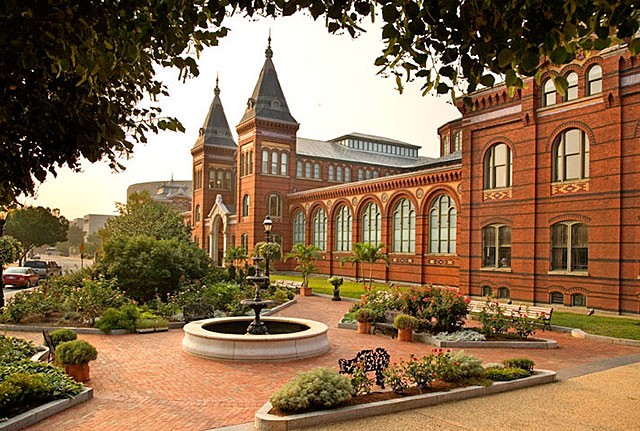
The Arts and Industries Building, originally the National Museum Building, under construction in 1879. Photo courtesy of the Smithsonian Institution Archives.
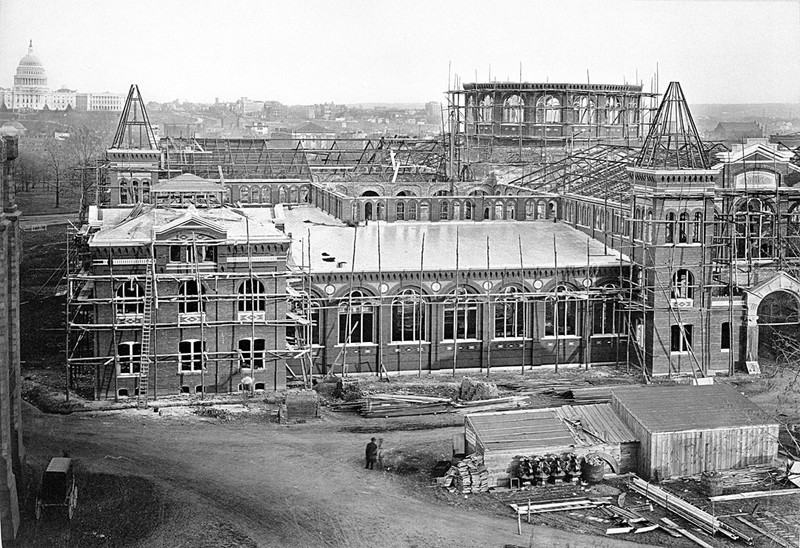
Floorplan of the National Museum in 1925. Courtesy of the Smithsonian Institution Archives.
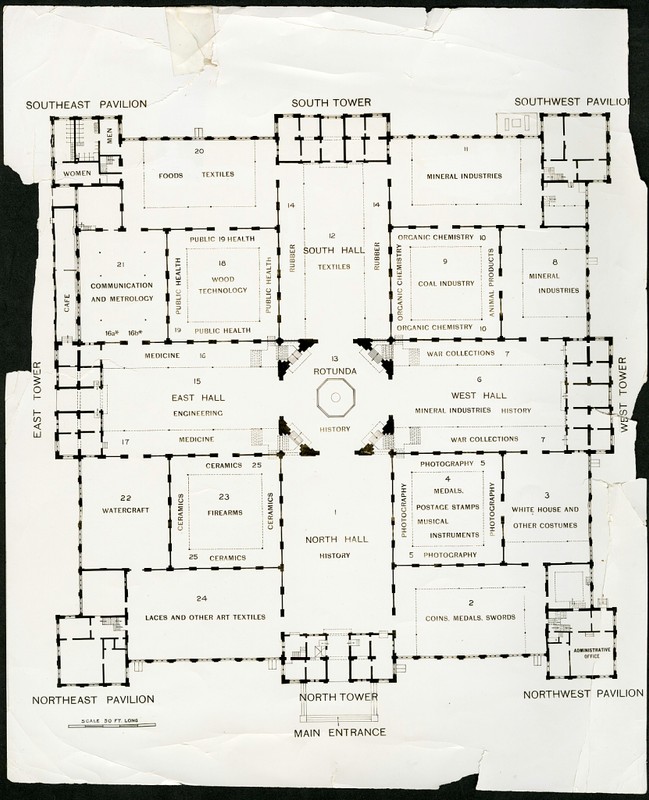
The West Hall of the National Museum decorated for the inaugural ball of President James Garfield in 1881. Photo courtesy of the Smithsonian Institution Archives.
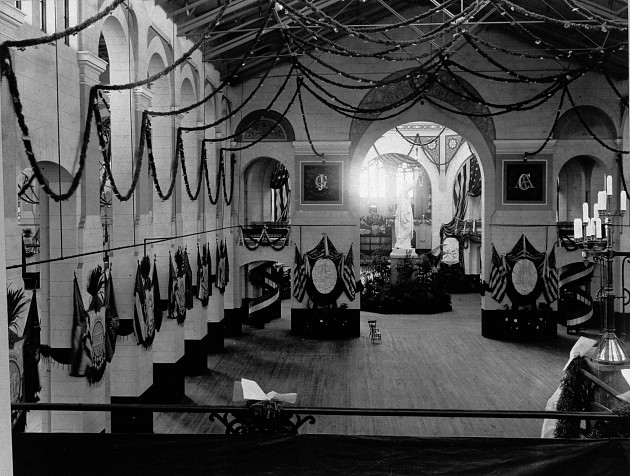
The National Museum's Water Transportation exhibit displayed canoes, sailing craft, and steamboats. Photo circa 1890s, courtesy of the Smithsonian Institution Archives.
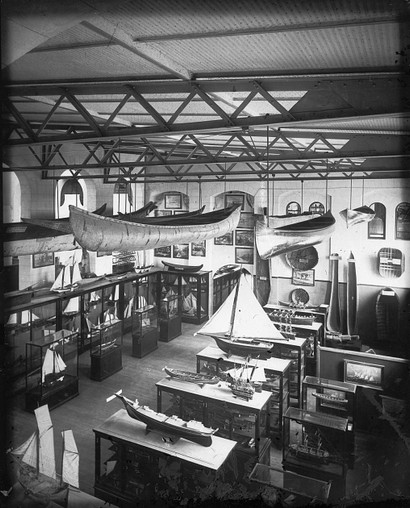
The First Ladies dresses exhibit was first on display at the Arts and Industries Building. Photo circa 1955, courtesy of the Smithsonian Institution Archives.
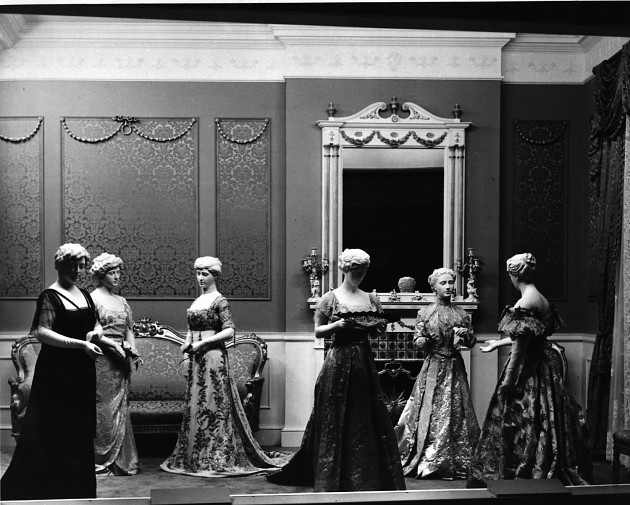
The 1903 Wright Flyer hangs in the North Hall of the Arts and Industries Building. Photo circa 1950s, courtesy of the Smithsonian Institution Archives.
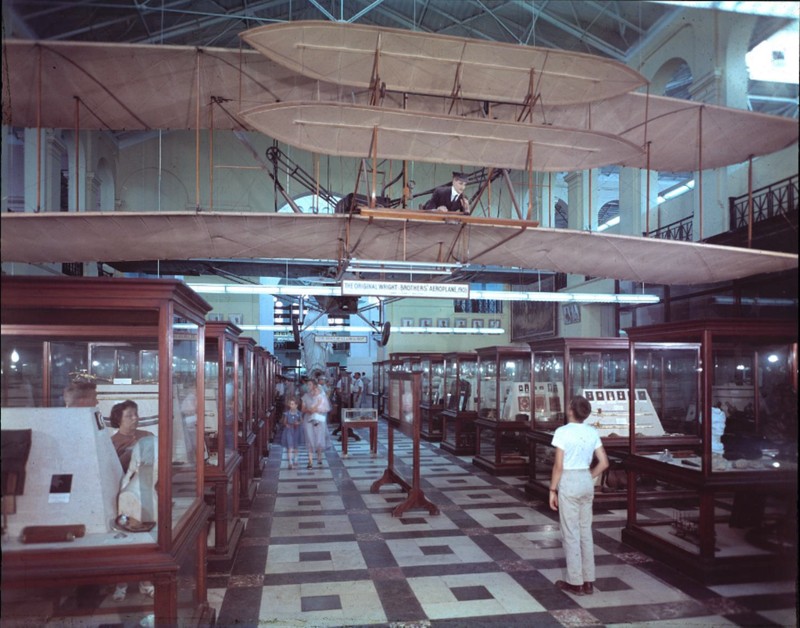
"Rocket Row" displayed historically-significant rockets before the National Air and Space Museum's building opened. Photo circa 1967, courtesy of the Smithsonian Institution Archives.
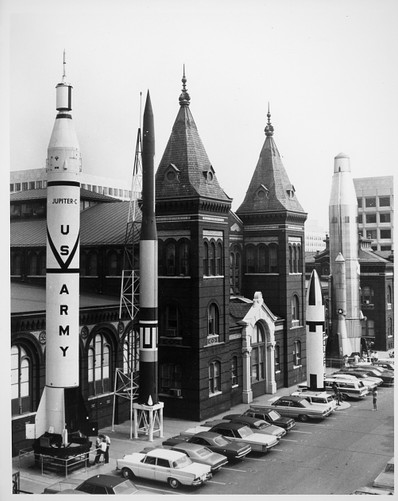
The statue atop the Arts and Industries building depicts Columbia protecting Science and Industry. Photo by Jamieadams99 on Wikimedia.
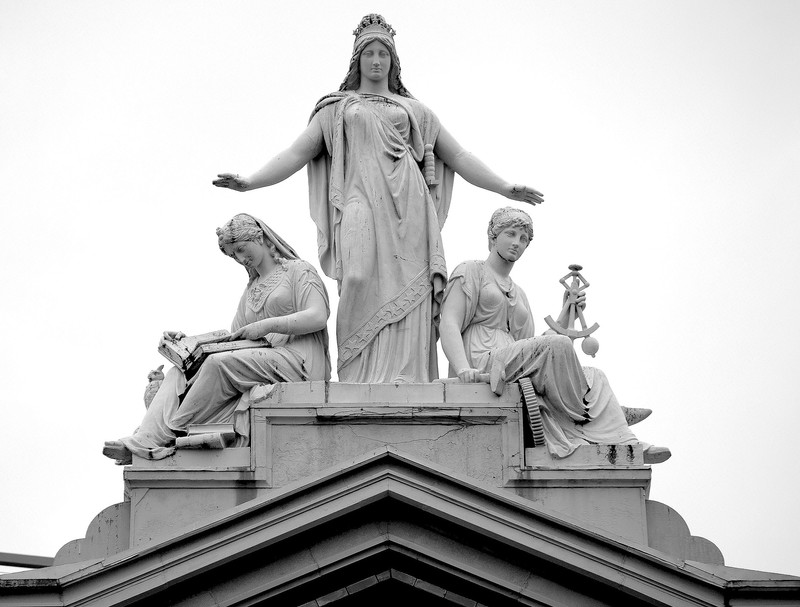
The Star-Spangled Banner was acquired by the Smithsonian in 1912. In this photo from the 1920s, the flag is displayed in a glass case against the wall. It is now housed in a climate-controlled room at the National Museum of American History.

Backstory and Context
Text-to-speech Audio
In 1850, Henry appointed Spencer F. Baird as the first curator of the Smithsonian's collections, which were originally housed in the Smithsonian Institution Building, also known as the Castle. As a naturalist, Baird focused on amassing a large collection of specimens that illustrated North American flora and fauna. In 1876, the Smithsonian also received collections and exhibitions from the Centennial International Exposition in Philadelphia. Baird understood that in order to continue growing, the Smithsonian would need more space and more methodical organization.2
Baird's dream came true with the National Museum Building. Constructed between 1879 and 1881, the National Museum Building was worldly in its collections and its architecture. Collections included natural history, American history, anthropology, and art. The National Museum Building was inspired by world's fairs and exposition architecture and borrowed Greek, Byzantine, and Moorish designs that were in fashion at the time. Its red brick complements the Castle yet contrasts much of the modern National Mall, which is lined with museums and monuments made of light-colored stone and marble. Architects chose red brick because it was "fireproof, economical, and versatile." The Building's design was open and festive with geometric patterns, skylights, colored brick accents and tiling, and a central rotunda. With its brilliant use of windows and ventilation, artificial lighting and heating and cooling systems were seldom needed. The National Museum Building hosted President James Garfield's inaugural ball on March 4, 1881, and opened to the public in October of that year.3
By 1910, the Smithsonian collections had already outgrown the National Museum Building. The natural history collections moved to the National Museum of Natural History across the Mall. The National Museum Building was then renamed the Arts and Industries Building and focused on displaying treasures of art and history, such as the Star-Spangled Banner, the Spirit of St. Louis, and First Ladies' dresses. Over the course of the twentieth century, the Smithsonian moved collections out of the Arts and Industries Building and into newly-constructed museums. Because so many museums originated from the Arts and Industries Building, it is often nicknamed the "incubator." These museums include the National Museum of American History, the Smithsonian American Art Museum, the National Portrait Gallery, the National Air and Space Museum, and the National Postal Museum. As collections departed, the Arts and Industries Building held exhibits, such as 1876: A Centennial Exhibition celebrating the fair that helped build the National Museum. Gardens added beautiful landscaping to the grounds in the 1980s.4
In the new millennium, the Arts and Industries Building thrived culturally, yet deteriorated physically. In 2004, though the Arts and Industries Building was home to exhibits, archives, offices, and 500 employees of various Smithsonian organizations, it closed due to cracks in the walls and flooring, leaks in the ceiling, pests, and poor internal systems. Since then, the Building has undergone extensive renovations to restore its former glory and take advantage of its historically sustainable construction. The future of the Arts and Industries Building is still being planned. In the meantime, it provides a space for pop-up exhibits and special events. Today, the words "National Museum" are still visible on the building's facade, a testament to its place in both American history and Smithsonian history.5
Sources
2. Smithsonian Institution, "Arts and Industries Building," Smithsonian Institution Archives; Smithsonian Institution, "Spencer Fullerton Baird, 1823-1887," Smithsonian Institution Archives.
3. Smithsonian Institution, "Arts and Industries Building," Smithsonian Institution Archives.
4. Smithsonian Institution, "Arts and Industries Building," Smithsonian Institution Archives; Smithsonian Institution, "Arts and Industries Building," Arts and Industries Building.
5. Blair, "Belle Of The Mall," NPR; Py-Lieberman, "Construction Underway," Smithsonian Magazine; Smithsonian Institution, "Arts and Industries Building," Arts and Industries Building.
Blair, Elizabeth. "Belle Of The Mall: Saving Smithsonian's Jewel-Like Arts And Industries Building." National Public Radio. August 25, 2016. Accessed September 2017. http://www.npr.org/2016/08/25/489457490/belle-of-the-mall-saving-smithsonian-s-jewel-like-arts-and-i...
Henry, Joseph. "Joseph Henry's 'Programme of Organization' for the Smithsonian Institution." December 13, 1847. Smithsonian Libraries. Accessed September 2017. http://www.sil.si.edu/Exhibitions/Smithson-to-Smithsonian/henry.htm
Py-Lieberman, Beth. "Construction Underway: Arts and Industries Building Gets a Little Love." Smithsonian Magazine. November 12, 2009. Accessed September 2017. http://www.smithsonianmag.com/smithsonian-institution/construction-underway-arts-and-industries-buil...
Smithsonian Institution. "Arts and Industries Building." Arts and Industries Building. Accessed September 2017. https://aib.si.edu
Smithsonian Institution. "Arts and Industries Building." Smithsonian Institution Archives. Accessed September 2017. https://siarchives.si.edu/history/arts-and-industries-building
Smithsonian Institution. "Joseph Henry, 1797-1878." Smithsonian Institution Archives. Accessed September 2017. https://siarchives.si.edu/history/joseph-henry
Smithsonian Institution. "Spencer Fullerton Baird, 1823-1887." Smithsonian Institution Archives. Accessed September 2017. https://siarchives.si.edu/history/spencer-fullerton-baird
Images:
"U.S. National Museum Under Construction." Photo. Circa 1879. Smithsonian Institution Archives, Record Unit 95, Box 32, Folder 7. Accessed September 2017. https://siarchives.si.edu/collections/siris_sic_5943
"U.S. National Museum Decorated for Garfield Inaugural Ball." Photo. Circa 1881. Smithsonian Institution Archives, Record Unit 95, Box 32, Folder 10. Accessed September 2017. https://siarchives.si.edu/collections/siris_sic_9971
"Floor Plan of the Arts & Industries Building, United States National Museum." Print. 1925. Smithsonian Institution Archives, Record Unit Record Unit 562, Box 1, Folder: Photographs, Interior and Exterior, A&I Building. Accessed September 2017. https://siris-sihistory.si.edu/ipac20/ipac.jsp?&profile=all&source=~!sichronology&uri=full=3100001~!7200~!0#focus
"Boat Hall, U. S. National Museum." Photo. Circa 1890s. Smithsonian Institution Archives, Record Unit 95, Box 43, Folder 10. Accessed September 2017. https://siarchives.si.edu/collections/siris_sic_9348
"First Ladies Hall in A&I Bldg, 1955." Photo. Circa 1955. Smithsonian Institution Archives, Record Unit 95, Box 42, Folder 17. Accessed September 2017. https://siarchives.si.edu/collections/siris_sic_9218
"Rocket Row on West Side of A&I Building." Photo. Circa 1967. Smithsonian Institution Archives, Record Unit 95, Box 32, Folder 6. Accessed September 2017. https://siarchives.si.edu/collections/siris_sic_9545
"Star-Spangled Banner in A&I." Photo. Circa 1920s. Smithsonian Institution Archives, Record Unit 285, Box 18, Folder: 3. Accessed December 2017. https://siarchives.si.edu/collections/siris_sic_9294
